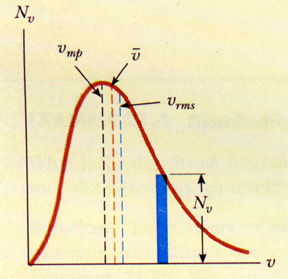The kinetic molecular theory states:
- A gas is composed of a very large number of extremely small particles that move in constant, random, straight-line motion
- Molecules of a gas are separated by great distances. The gas is mostly empty space
- Molecules collide only fleetingly with one another and with the walls of their container and most of the time, molecules are not colliding
- There are assumed to be no forces between molecules except very briefly during collisions. That is, each molecule acts independently of all others and is unaffected by their presence, except during collisions.
- Individual molecules may gain or lose energy as a result of collisions. In a collection of molecules at a constant temperature, however, the total energy remains constant.
- The frequency of molecular collisions-- the number of collisions per seconds. The higher the frequency, the greater the total force on the wall of the container. Collision frequency increases with the number of molecules per unit volume and with molecular speeds.
Collision frequency
proportional (Ux) x (N/V)
2. The momentum transfer, or impulse. When a molecule hits the wall of the vessel, momentum is transferred as the molecule reverses direction. This momentum transfer is called an IMPULSE. The magnitude of the impulse is directly proportional to the mass m, of a molecule and its speed.
Impulse
(momentum transfer) proportional (mass of particle) X (molecular speed)
Impulse
proportional (mux)
The pressure of a gas (P) is the product of impulse and collision frequency.
Pressure (P)
proportional (N/V)mux2
Note that since molecules are travelling at different speeds, we must replace the speed with the average speed which is denoted by the same symbol with a bar above it.
Thus, the basic equation for kinetic molecular theory of gases is :
DISTRIBUTION OF MOLECULAR SPEEDS
As mentioned earlier, molecules are travelling at different speed and thus it is difficult to determine the speed of each of the molecules. Instead, we can determine the fraction, F, of molecules that have speed u , given by the following equation:
where k= Gas constant R.
The distribution of molecular speeds can be displayed through the following graph:
The distribution depends of the product of two opposing factors: a factor that is proportional to u^2 and the exponential factor, e^(-Mu^2/2RT). As u increases, the u^2 factor increases from a value of 0 while the exponential factor decreases from 1. The u^2 factor is favours the presence of molecules at high speeds while keeping fewer molecules away from zero while the exponential factor favors low speeds and limits the number of molecules having high speeds. Since F is composed of the product of opposing factors, F increases from a value of zero, reaches a max and then decreases as u increases.
There are three characteristic speeds labeled on the diagram. What are they?
- Um is the most probable speed, or modal speed-more molecules have this speed than any other speed
- U(avg) or U(bar) is the average speed
- U(rms) is the root-mean-square speed which is used to calculate the average kinetic energy of a collection of molecules. The U(rms) can be calculated using the following equation:
Note that R must be equal to 8.3145 J/mol.K.
From the equation, we can determine that :
- Molecular speeds increase as temperature increases
- Lighter gas molecules have greater speeds than do heavier ones
MEANING OF TEMPERATURE
This equation states :
The Kelvin temperature (T) of a gas is proportional to the average translational kinetic energy of its molecules
WALL COLLISION RATE








No comments:
Post a Comment